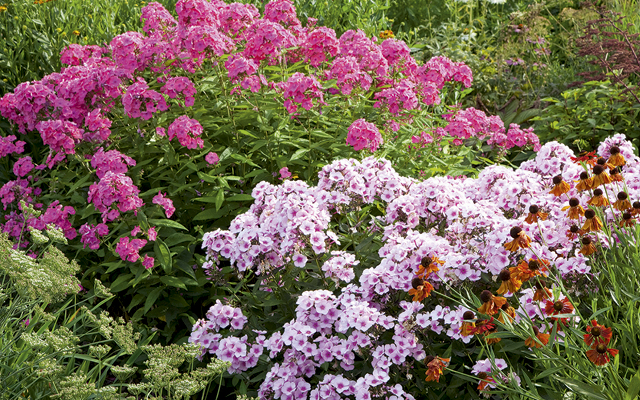How to grow border phlox
Alan Titchmarsh recommends bright eyes for borders.


Some garden plants are star performers, given top billing, but others seem to be consigned to the back row of the chorus. Such is the lot of the border phlox, usually tucked somewhere into the middle of a border, but when the brightest varieties of Phlox paniculata burst into bloom from midsummer onwards, they take their bow with confidence and are hugely useful for filling the void created by those stars who give their all in the first act of summer, such as lupins and delphiniums.
If you remember phlox from your childhood, then you may have reservations about growing them, for many of the older varieties were martyrs to powdery mildew (still prevalent when the plants are grown in poor, dry soil) and eelworm (which results in splitting of the stems and deformed leaves).
Buy clean, healthy stock and plant them in the right place and neither of these problems is likely to lose you any sleep. (Any that are eventually affected by eelworm can be propagated from root cuttings laid in boxes of sandy compost in autumn.)
But neither of these problems should beset you if you choose a spot for your initially healthy plants that offers rich, moistureretentive soil and full sun or dappled shade. On lighter soils, be generous with the well-rotted manure or garden compost at planting time as well as a good sprinkling of blood, bone and fishmeal and lay an organic mulch on the ground around them in spring when the soil is still moist. That will make it easier for them to find the water resources they so enjoy.
Phlox don’t like boggy ground, but thin, sandy earth is insufficient to sustain their generous growth rate. In prolonged dry summers, when mildew is most likely, irrigation will keep it at bay. There are quite literally hundreds of varieties, varying in height from 2ft to 4ft, and a range of colours from pure white through pale to dark pinks, salmon, orange, pale blue, lilac and magenta, often with a contrasting ‘eye’.
Many of them are fragrant, although, to some noses, this fragrance is difficult to detect. Bright Eyes (pale pink with a darker eye), Starfire (carmine red) and White Admiral are among the best, although I find Harlequin, with its variegated foliage and purplish-pink flowers, a bit garish.
Plant border phlox 12in–18in apart and dig them up and divide them in autumn (on light soils) or spring (on heavier soils) every three or four years (they expand rapidly). They’re also prime candidates for the ‘Chelsea chop’ cutting back half the stems to half their height in late May with the intention of delaying flowering on the chopped stems by several weeks, spreading the season of interest.
Sign up for the Country Life Newsletter
Exquisite houses, the beauty of Nature, and how to get the most from your life, straight to your inbox.
I’ve never been able to bring myself to do this, being too greedy for a fine show in their natural season. But then, in my own garden, as well as being valued border plants, I also grow a couple of dozen in rows in the kitchen garden; they last well enough in a vase to make it worthwhile and the effect of mixed colours is spectacular.
Oh, and joy of joys the stems are so sturdy that none of the varieties I grow needs staking and that’s a real plus when I’m running round pushing in twiggy pea sticks in April and May and tying in the towering spires of delphiniums in June.
Your phlox or phloxes will flower between late June and September, depending on variety, each lasting for about four or five weeks, and the plants can be dead-headed when the last terminal buds on each of the generously sized panicles have faded. In my book, they’re stalwarts of the border that deserve far greater recognition than they’re currently given. Try them and see if you don’t agree.
Country Life is unlike any other magazine: the only glossy weekly on the newsstand and the only magazine that has been guest-edited by HRH The King not once, but twice. It is a celebration of modern rural life and all its diverse joys and pleasures — that was first published in Queen Victoria's Diamond Jubilee year. Our eclectic mixture of witty and informative content — from the most up-to-date property news and commentary and a coveted glimpse inside some of the UK's best houses and gardens, to gardening, the arts and interior design, written by experts in their field — still cannot be found in print or online, anywhere else.
-
 'Monolithic, multi-layered and quite, quite magnificent. This was love at first bite': Tom Parker Bowles on his lifelong love affair with lasagne
'Monolithic, multi-layered and quite, quite magnificent. This was love at first bite': Tom Parker Bowles on his lifelong love affair with lasagneAn upwardly mobile spaghetti Bolognese, lasagne al forno, with oozing béchamel and layered meaty magnificence, is a bona fide comfort classic, declares Tom Parker Bowles.
By Tom Parker Bowles
-
 Country houses, cream teas and Baywatch: Country Life Quiz of the Day, April 24, 2025
Country houses, cream teas and Baywatch: Country Life Quiz of the Day, April 24, 2025Thursday's Quiz of the Day asks exactly how popular Baywatch became.
By Toby Keel